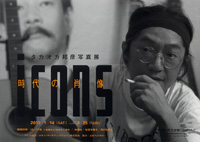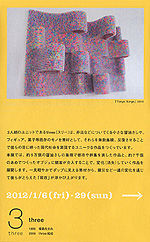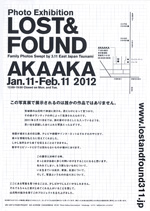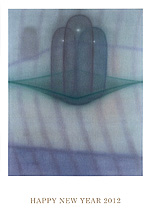 |
Picks is a monthly sampling of Japan's art scene, offering short reviews of exhibitions at museums and galleries in recent weeks, with an emphasis on contemporary art by young artists. |
 |
 |
|
|
 |
 |
 |
 |
Kunihiko Takaoka: Icons
|
| 14 January - 25 March 2012 |
Machida Citizen's Literary Hall "Kotoba Land"
(Tokyo) |
 |
| Photographer Takaoka's show at Kotoba (Word) Land consists of some 90 portraits of novelists, poets, lyricists and dramatists. The images are divided into three categories: "portrait" features black-and-white close-ups of the subjects' faces; "image" shows them in informal dress; and "studio" captures the writers in their workplaces. Kotoba Land, incidentally, was originally built to house the collection of Shusaku Endo (1923-96) paraphernalia donated by the family of the renowned author to his adopted hometown of Machida. |
|
 |
|

|
 |
 |
|
|
|
|
|
 |
 |
 |
|
|
three
|
|
6 - 29 January 2012
|
Shiseido Gallery
(Tokyo) |
 |
| First in the "shiseido art egg" series introducing young artists and art groups, the three-person unit aptly named "three" hails from Fukushima. Their exhibition consists of two large installations. One is an undulating wall made of 50,000 tiny soy sauce containers. The other consists of some 7,000 candies and gumdrops suspended by threads from the ceiling of the main gallery and forming the contours of a house. The group's use of vast quantities of everyday items to take a poppish poke at contemporary society is entertaining enough, but what gives the latter piece special charm is a hidden riddle that will bring joy to any art geek. |
|
|
|
|
|
|
 |
 |
|
|
Lost & Found: Family Photos Swept by 3.11 East Japan Tsunami
|
|
11 January - 11 February 2012
|
AKAAKA
(Tokyo) |
 |
| The town of Yamamoto in southern Miyagi Prefecture was half-inundated by the March 11 tsunami. Very soon after the disaster, Project Salvage Memory was launched by volunteers who collected the photographs that rescue and cleanup parties had found in the muck and debris, washed them, digitized them, and sought to return them to their owners. Out of the tens of thousands of salvaged photos, some 12,000 have been returned so far. This exhibition displays a sampling, in conditions ranging from nearly pristine to unrecognizable, of those that remain unclaimed. The show moves on to Los Angeles in March, and Paris after that. |
|
 |
 |
 |
|
| Sachie Horigome |
| 14 - 28 January 2012 |
Gallery Tsubaki
(Tokyo) |
 |
| Horigome paints soft-focus oils of colored glass bottles, but these are not ordinary still lifes. Truncating, streamlining, or otherwise altering the shapes of the vessels, the artist creates forms that verge on the abstract. They remind one a bit of Giorgio Morandi's work, but by applying many layers of paint, Horigome achieves her own uniquely luminous transparency, one that testifies to the magic of oil paint. |
|
|
|
|
 |
|
|
 |
|